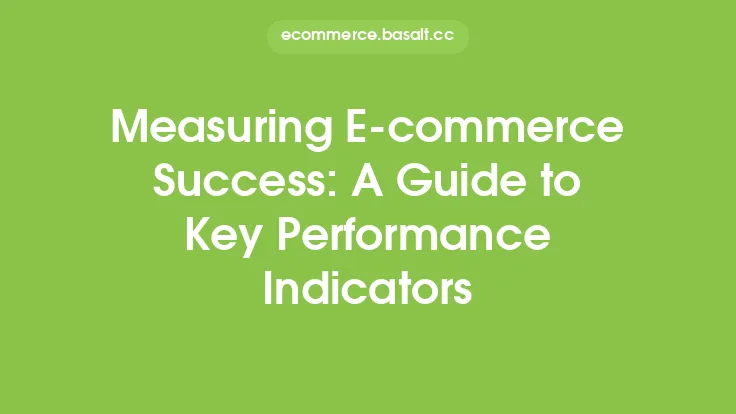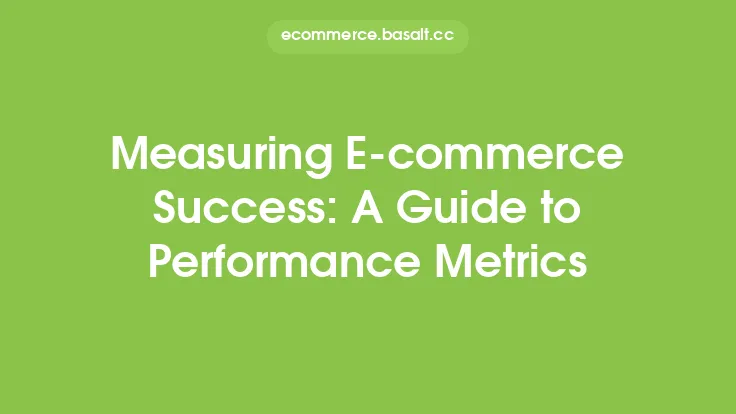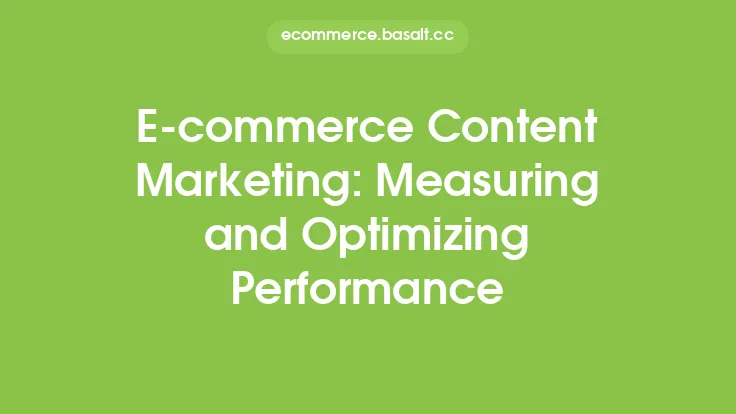Measuring the performance of an e-commerce business is crucial for its success and growth. With the ever-increasing competition in the online market, it's essential to have a comprehensive understanding of how your e-commerce platform is performing. This involves tracking various metrics, analyzing data, and making informed decisions to optimize your business strategies. In this article, we'll delve into the world of e-commerce performance measurement, exploring the key aspects, tools, and best practices to help you achieve your business goals.
Introduction to E-commerce Performance Metrics
E-commerce performance metrics are quantifiable measures that help you evaluate the effectiveness of your online business. These metrics can be categorized into several groups, including sales and revenue, customer behavior, marketing, and operational efficiency. By tracking these metrics, you can identify areas of strength and weakness, set realistic targets, and develop strategies to improve your overall performance. Some common e-commerce performance metrics include conversion rates, average order value, customer acquisition cost, and retention rates. Understanding these metrics and their interrelationships is vital for making data-driven decisions that drive business growth.
Setting Up E-commerce Analytics Tools
To measure e-commerce performance effectively, you need to set up analytics tools that can collect, process, and provide insights into your business data. Google Analytics is a popular choice among e-commerce businesses, offering a wide range of features and integrations. However, there are other tools available, such as Adobe Analytics, Piwik, and Matomo, each with its strengths and weaknesses. When selecting an analytics tool, consider factors like data accuracy, customization options, and scalability. It's also essential to ensure that your analytics tool is properly integrated with your e-commerce platform, allowing for seamless data collection and analysis.
Data Collection and Integration
Data collection is a critical aspect of e-commerce performance measurement. You need to collect data from various sources, including your website, social media, customer reviews, and marketing campaigns. This data should be integrated into your analytics tool, providing a unified view of your business performance. Data integration can be challenging, especially when dealing with multiple data sources and formats. To overcome these challenges, consider using data integration platforms like Zapier, Segment, or Stitch, which can help you connect your data sources and streamline data collection.
E-commerce Key Performance Indicators (KPIs)
E-commerce KPIs are specific metrics that help you evaluate the performance of your online business. These KPIs can be categorized into several groups, including sales, customer behavior, marketing, and operational efficiency. Some common e-commerce KPIs include:
- Conversion rates: The percentage of website visitors who complete a desired action, such as making a purchase.
- Average order value (AOV): The average amount spent by customers in a single transaction.
- Customer acquisition cost (CAC): The cost of acquiring a new customer, including marketing and advertising expenses.
- Customer retention rate: The percentage of customers who return to your website for repeat purchases.
- Cart abandonment rate: The percentage of customers who abandon their shopping carts without completing a purchase.
By tracking these KPIs, you can identify areas for improvement and develop targeted strategies to optimize your business performance.
Analyzing E-commerce Data
Analyzing e-commerce data is essential for gaining insights into your business performance. This involves using various techniques, such as data visualization, segmentation, and correlation analysis, to identify trends, patterns, and relationships in your data. Data visualization tools like Tableau, Power BI, or D3.js can help you create interactive and dynamic dashboards, providing a clear and concise view of your business performance. Segmentation analysis can help you identify specific customer groups, allowing you to develop targeted marketing campaigns and improve customer engagement. Correlation analysis can help you identify relationships between different metrics, enabling you to optimize your business strategies and improve overall performance.
Best Practices for E-commerce Performance Measurement
To get the most out of your e-commerce performance measurement efforts, follow these best practices:
- Set clear and realistic goals: Establish specific, measurable, achievable, relevant, and time-bound (SMART) goals for your e-commerce business.
- Track relevant metrics: Focus on metrics that align with your business goals and objectives.
- Use data visualization: Create interactive and dynamic dashboards to provide a clear and concise view of your business performance.
- Analyze data regularly: Regularly review and analyze your data to identify trends, patterns, and relationships.
- Take action: Use your data insights to inform business decisions and drive growth.
By following these best practices, you can ensure that your e-commerce performance measurement efforts are effective, efficient, and aligned with your business goals.
Common Challenges in E-commerce Performance Measurement
E-commerce performance measurement can be challenging, especially when dealing with large datasets, multiple data sources, and complex analytics tools. Some common challenges include:
- Data quality issues: Ensuring that your data is accurate, complete, and consistent can be a significant challenge.
- Data integration: Integrating data from multiple sources and formats can be time-consuming and require significant resources.
- Analytics tool selection: Choosing the right analytics tool for your e-commerce business can be overwhelming, especially with the numerous options available.
- Data analysis: Analyzing large datasets and identifying meaningful insights can be a complex and challenging task.
To overcome these challenges, consider seeking guidance from e-commerce analytics experts, investing in data quality and integration tools, and developing a comprehensive analytics strategy that aligns with your business goals.
Future of E-commerce Performance Measurement
The future of e-commerce performance measurement is exciting and rapidly evolving. With the increasing use of artificial intelligence, machine learning, and the Internet of Things (IoT), e-commerce businesses can expect to see significant advancements in analytics tools and techniques. Some potential trends and developments include:
- Predictive analytics: Using machine learning algorithms to predict customer behavior, sales, and revenue.
- Real-time analytics: Analyzing data in real-time to provide instant insights and enable rapid decision-making.
- Personalization: Using data and analytics to create personalized customer experiences and improve engagement.
- Voice commerce: Measuring the performance of voice-activated shopping and optimizing voice commerce strategies.
As the e-commerce landscape continues to evolve, it's essential to stay up-to-date with the latest trends, tools, and best practices in e-commerce performance measurement. By doing so, you can ensure that your business remains competitive, agile, and poised for growth in an ever-changing market.





